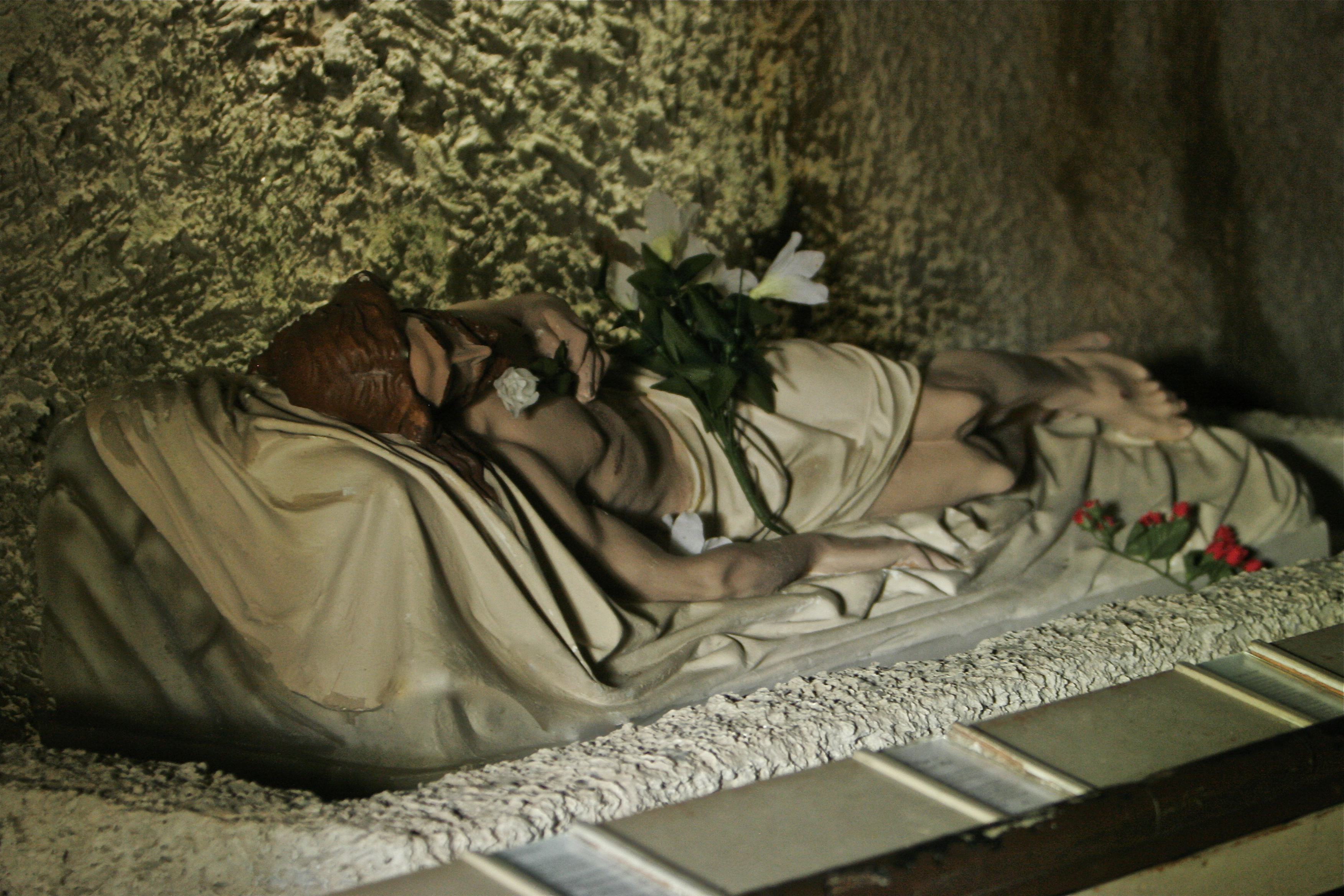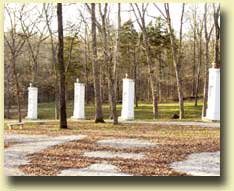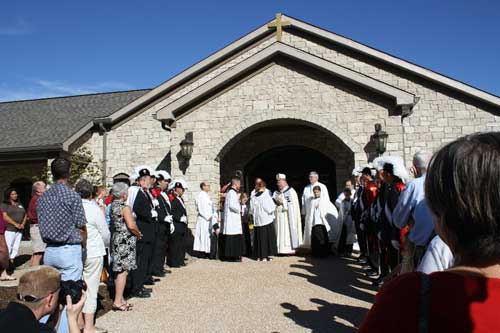
The Beginning of St. Martin's Church
and the Shrine of Our Lady of Sorrows
|
In the year 1847 the first people came to the area known as
Rhineland or Loutre Island, along the Missouri River. The
area was soon to be named "Starkenburg." The settlers were
Germans from the Hermann, Missouri area. They would have special
services when missionaries came. In this barn was a statue,
which the Germans named "Weisse dame" or "White Lady." On Sunday, June 21, 1891, when the 300th anniversary of St. Aloysius was commemorated, the rain poured down in torrents. The weather continued for almost six weeks. Farmers could not venture into the fields to cut their over-ripened wheat. Father Hoehn remembered when many years ago, in his homeland, the region had been in the throes of a terrible drought. The residents made a solemn promise to build a chapel if their prayers for rain were answered. Rain fell, and the Chapel was built. Father Hoehn thought that if the Mother of God heard the prayers of those children, she would not ignore the voice of these, even though they desired just the reverse result. On the same afternoon, a solemn annual pilgrimage was vowed to the Blessed Virgin in the Chapel, if the rains would cease, so the farmers could work in the fields. The following day dawned bright and clear, and one beautiful day followed another.
The farmers harvested their crops and the church was finished the
same year without serious interruptions. The nave of the
structure was enlarged. Towards the south the wall is
gable-shaped. Here, the pilgrims, when still at a distance,
may see a statue of the Blessed Mother with her Divine Child,
raised aloft in a niche, to greet the coming wanderer. The
steeple to the front of the Church reaches a height of 125
feet. The exterior appearance of the Church was greatly
improved by the changes and additions made. The New
Chapel
As the number of pilgrims continued to mount, it soon became
necessary to build a larger chapel. Beginning in September of
1900, Father Hoehn published a monthly magazine entitled, Der
Pilger (The Pilgrim). It was written, half in English, and
half in German. Collections for the new chapel began in
1902. Many of the pilgrims subscribed to the magazine, which
related work in progress and plans for the Shrine. Proceeds
from the sale of Der Pilger had amounted to several thousands of
dollars, and this represented the beginning of the fund
drive. Dedication of the New Chapel
The White Lady, which had been the inspiration for the chapel in
the woods, was to be returned to that place. Now, painted in
beautiful colors and draped in a white German robe, She was carried
to the chapel. Father Hoehn relates the event: "Something
touching occurred the day preceding the consecration. The
old, venerable image of the year 1852, with which the pilgrimage
had begun in 1888, was carried to the new chapel in solemn
procession by maidens of the congregation, accompanied by priests,
members of the congregation, and pilgrims. There at the
entrance, it was taken from four aged, honorable matrons and
carried to the beautiful marble high altar of the chapel, where it
was place in the main niche." These women had carried the
White Lady in procession more than 50 years before. They were
Mrs. Christina Struttmann, Mrs. Helene Scholten, Mrs. Johanna
Fluecht, and Mrs. Adelheid Pottebaum. The statue and the
altar were then incensed, and prayers of consecration
offered. The Gertken family of St. Louis donated the altar,
which cost $1,500. The family saved ten-dollar gold pieces
over a period of three years. Description of the Chapel The chapel is constructed entirely of stone in
the early Rhenish-Romanesque style. It is 69 feet long and 43
feet wide. Its height to the gable is 50 feet and to the
right of the sanctuary the tower walls reach 67 feet. The
spire, in typical Romanesque style, is
short. |
 area. In
1873, Rev. Joseph Schaefer, the pastor, placed the White Lady in
the newly erected Stone Church, St. Martin's Church. In 1874,
a Gothic-style church was consecrated. There was a large
bell, several statues, and stained glass windows. In 1877,
the Franciscans took charge of the Parish. For a few years,
the Madonna remained in the Church. Then, a larger and
more elegant statue replaced it, and the former was placed in an
attic.
area. In
1873, Rev. Joseph Schaefer, the pastor, placed the White Lady in
the newly erected Stone Church, St. Martin's Church. In 1874,
a Gothic-style church was consecrated. There was a large
bell, several statues, and stained glass windows. In 1877,
the Franciscans took charge of the Parish. For a few years,
the Madonna remained in the Church. Then, a larger and
more elegant statue replaced it, and the former was placed in an
attic. 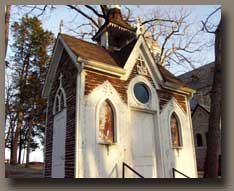
 cases raised on
posts. The woods now received a special blessing and no
cattle or vehicles were permitted to cross the
premises.
cases raised on
posts. The woods now received a special blessing and no
cattle or vehicles were permitted to cross the
premises. 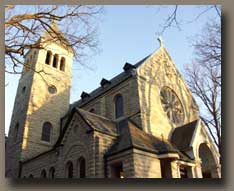 cornerstone." Prayers asking for blessing of the
Almighty followed a procession to the small
chapel.
cornerstone." Prayers asking for blessing of the
Almighty followed a procession to the small
chapel.  the Grotto of
Lourdes, with the Ave Maria resounding through the trees. A
short devotion was held at Mt. Olivet, and then the procession
continued to the chapel. Reverend Charles Schaefers of St.
Mary's in Moberly delivered a sermon in which he spoke of "Mary,
the mystical rose in God's garden, a delight to angels and
man."
the Grotto of
Lourdes, with the Ave Maria resounding through the trees. A
short devotion was held at Mt. Olivet, and then the procession
continued to the chapel. Reverend Charles Schaefers of St.
Mary's in Moberly delivered a sermon in which he spoke of "Mary,
the mystical rose in God's garden, a delight to angels and
man." 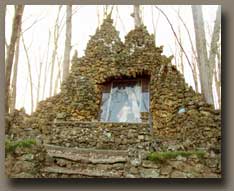 chapel
exclaimed, "You have built a really beautiful chapel!"
chapel
exclaimed, "You have built a really beautiful chapel!"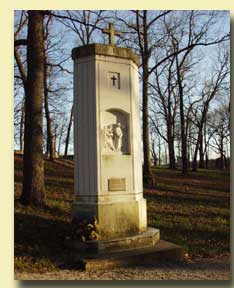 have heard the
first ringing of the bell in the stone chapel.
have heard the
first ringing of the bell in the stone chapel. 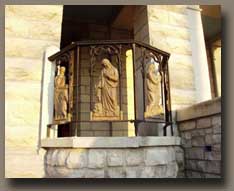 the new
pulpit so that a touch of the old merges with the
new.
the new
pulpit so that a touch of the old merges with the
new. 